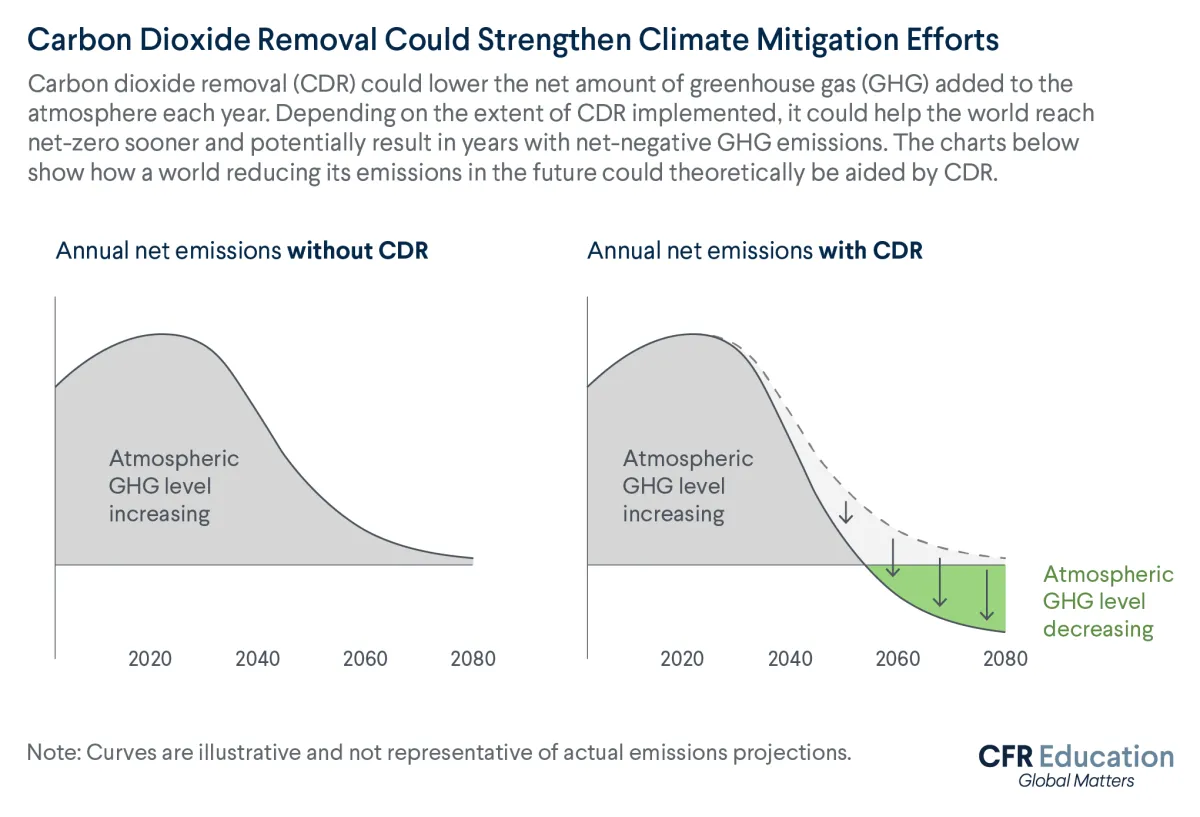What Is Geoengineering?
Learn more about the promises and perils of artificially manipulating the environment to combat climate change.
Generations of human-driven greenhouse gas emissions are warming the planet to dangerous levels. Scientists agree that the best way to combat climate change is to reduce emissions—an effort known as mitigation. Unfortunately, however, countries have been slow to make those reductions.
What’s more, carbon dioxide—the primary, planet-warming greenhouse gas—sticks around in the atmosphere for a long time. Even if countries were to magically eliminate all emissions overnight, the carbon dioxide humans have emitted since the Industrial Revolution could linger for up to a thousand years. This means that, even in the most optimistic scenarios, the consequences of climate change are likely baked in for decades.
But what if there were other ways to combat climate change? What if, say, one could find a way to pull carbon dioxide in vast quantities out of the atmosphere? That may sound like the stuff of science fiction, but it’s in fact a common planetary process that trees have been doing for millions of years. Today, some scientists are exploring a new category of technology known as geoengineering. It includes—among other things—reflecting solar radiation back into space and removing carbon dioxide from the atmosphere.
Geoengineering presents opportunities for combating climate change. However, scientists warn that the emerging technologies could also pose large risks.
This learning resource breaks down the science of geoengineering, explores its planetary upshot, and considers its potential for unanticipated consequences.
What is geoengineering?
Geoengineering is a category of emerging technology that can manipulate the environment to manage or mitigate the effects of climate change. It generally involves either pulling planet-warming emissions out of the atmosphere or addressing the effects of having so much greenhouse gas in the atmosphere.
Let’s explore some frequently discussed approaches:
Carbon dioxide removal
This approach involves finding new ways to remove the carbon dioxide that traps that radiation in the atmosphere. Trees already naturally conduct carbon dioxide removal, absorbing huge quantities of the greenhouse gas annually from the atmosphere. That type of geoengineering can take several forms, including the following:
- Direct air capture—Much like a giant air purifier, this technology uses mechanical devices or chemical processes to capture carbon dioxide directly from the atmosphere and store it underground. The United States saw its first commercial, direct air capture facility open in November 2023.
- Ocean fertilization—This approach would involve dumping iron pellets or other nutrients into the oceans. Those materials would help the tiny ocean plants called phytoplankton grow. Phytoplankton absorb carbon dioxide and use sunlight to turn it into food through photosynthesis.
- Carbon mineralization—Certain minerals in rocks react with carbon dioxide, absorbing and locking the greenhouse gas into the rock. There are multiple ways of artificially speeding up this natural absorption. One is by crushing the carbon dioxide–absorbent rocks and spreading them across the ground, typically on coastlines and agricultural fields.
- Reforestation—Arguably the easiest solution involves simply planting more trees. By planting trees on a massive scale, one can increase carbon sequestration through natural processes.
Solar radiation management
Heat from the sun keeps the planet at the temperature needed to sustain life. However, excessive greenhouse gas emissions are trapping more and more solar radiation, contributing to planetary warming.
In response, solar radiation management looks to lower temperatures by reducing incoming radiation. That process can also occur naturally. The volcanic eruption of Mount Pinatubo in the Philippines in 1991 released millions of tons of sulfur dioxide into the atmosphere. Those particles acted like tiny mirrors that reflected solar radiation and contributed to global temperatures temporarily decreasing by 0.9°F the following year.
Solar radiation management looks to artificially replicate that natural process. It can take several forms, including the following examples:
- Stratospheric aerosol geoengineering—Similar to volcanoes, this technology would seed the atmosphere with sulfate aerosols released from airplanes or balloons. Such seeding would reflect some of the sun’s planet-warming radiation.
- Marine cloud brightening—Already, clouds and the atmosphere reflect about one-third of radiation back toward the sun, and they also absorb another 20 percent. Marine cloud brightening involves spraying salt water into clouds would increase their presence and reflectivity.
- Space mirrors—Perhaps the most dramatic approach would involve placing massive mirrors—potentially the size of Brazil—into orbit to reflect solar radiation before it even reaches the planet.
There are other geoengineering approaches for tackling the effects from excessive greenhouse gas emissions. For example, scientists are exploring ways to fight sea level rise by slowing the speed at which glaciers and arctic sea ice melt. Some ideas involve building massive curtain-like structures that are anchored to the seabed and block warm water currents from reaching glaciers. Climate scientists are also examining how spreading reflective materials over glaciers could help shield the ice from solar radiation.
What are the concerns about geoengineering?
Geoengineering has not yet been deployed on a massive scale. In part, that is because the science is still new. But even if those technologies were readily available, policymakers and scientists debate whether geoengineering should ever be used at all. Geoengineering has profound potential for combating climate change, but the technology also has enormous possible downsides.
For example, solar radiation management does not address the root cause of climate change: human-driven greenhouse gas emissions. A particularly dangerous scenario could occur if the world deploys solar radiation management for several years without curbing emissions. If countries were to suddenly pause their solar geoengineering, temperatures would almost immediately rebound to perilous levels. Many species would be unable to survive such a sudden change in conditions.
Carbon dioxide removal, on the other hand, offers the opportunity to attack the source of planetary warming and reverse generations of carbon emissions. Even if the world blows past its climate goals—as it's currently projected to do—carbon dioxide removal could offer an opportunity to rewind the clock and roll back some of those climate damages. Nevertheless, there are still durability concerns with carbon dioxide renewal. For example, if humans relied on extensive reforestation to pull carbon dioxide out of the atmosphere, wildfires or other events could still lead to those forests being destroyed and releasing the carbon dioxide back into the atmosphere.
Additionally, many climate experts and activists argue that fixating on largely undeveloped geoengineering technology can distract from the top climate priority: curbing greenhouse gas emissions from the burning of fossil fuels. Also, costs can be a concern. While some methods like reforestation are relatively affordable and easy to implement, other approaches are not. For example, the U.S. government is investing billions of dollars into direct air capture with no guarantee that the technology can scale up fast enough to help avoid the worst effects of climate change. Additionally, some geoengineering projects could have unanticipated catastrophic consequences. (For example, there are concerns that ocean fertilization could reduce water oxygen levels in certain regions to a degree that it kills off many fish and destroys marine ecosystems.)
What are the rules around geoengineering?
Climate change is a transnational issue; emissions in one country contribute to warming worldwide. Just as the causes of climate change cross borders, so too could the potential solutions. Many countries will experience the benefits or drawbacks from any single nation’s undertaking of stratospheric aerosol geoengineering or ocean fertilization.
Furthermore, whereas mitigation requires the entire world’s participation, a single nation or even a nonstate actor could undertake geoengineering. It is conceivable that an enterprising billionaire could launch sulfate aerosols into the atmosphere in an attempt to single-handedly save the planet.
Presently, however, comprehensive international rules and regulations governing the research, testing, or deployment of geoengineering technologies do not exist. Various international bodies such as the Intergovernmental Panel on Climate Change have discussed geoengineering in assessment reports. Even so, they have yet to develop concrete governance mechanisms to regulate the technology.
Given the promises and perils of this emerging field, geoengineering governance is likely to become a major topic of global debate in the years to come.









